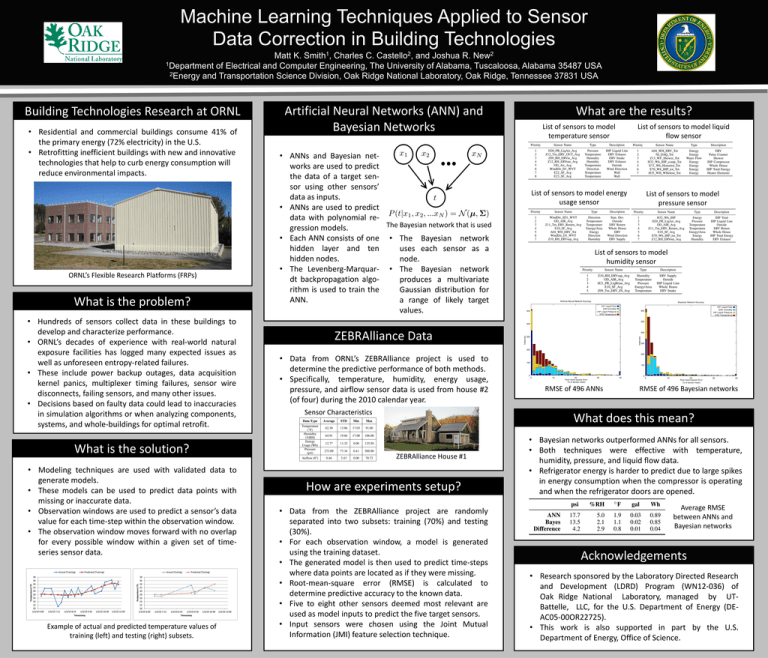Machine Learning Techniques Applied to Sensor Data Correction in Building Technologies
advertisement

Machine Learning Techniques Applied to Sensor Data Correction in Building Technologies Matt K. Smith1, Charles C. Castello2, and Joshua R. New2 1Department of Electrical and Computer Engineering, The University of Alabama, Tuscaloosa, Alabama 35487 USA 2Energy and Transportation Science Division, Oak Ridge National Laboratory, Oak Ridge, Tennessee 37831 USA Building Technologies Research at ORNL • Residential and commercial buildings consume 41% of the primary energy (72% electricity) in the U.S. • Retrofitting inefficient buildings with new and innovative technologies that help to curb energy consumption will reduce environmental impacts. ORNL’s Flexible Research Platforms (FRPs) What is the problem? • Hundreds of sensors collect data in these buildings to develop and characterize performance. • ORNL’s decades of experience with real-world natural exposure facilities has logged many expected issues as well as unforeseen entropy-related failures. • These include power backup outages, data acquisition kernel panics, multiplexer timing failures, sensor wire disconnects, failing sensors, and many other issues. • Decisions based on faulty data could lead to inaccuracies in simulation algorithms or when analyzing components, systems, and whole-buildings for optimal retrofit. What is the solution? • Modeling techniques are used with validated data to generate models. • These models can be used to predict data points with missing or inaccurate data. • Observation windows are used to predict a sensor’s data value for each time-step within the observation window. • The observation window moves forward with no overlap for every possible window within a given set of timeseries sensor data. Add p values Example of actual and predicted temperature values of training (left) and testing (right) subsets. Artificial Neural Networks (ANN) and Bayesian Networks • ANNs and Bayesian networks are used to predict the data of a target sensor using other sensors’ data as inputs. • ANNs are used to predict data with polynomial reThe Bayesian network that is used gression models. • Each ANN consists of one • The Bayesian network hidden layer and ten uses each sensor as a hidden nodes. node. • The Levenberg-Marquar- • The Bayesian network dt backpropagation algoproduces a multivariate rithm is used to train the Gaussian distribution for ANN. a range of likely target values. What are the results? List of sensors to model temperature sensor List of sensors to model liquid flow sensor List of sensors to model energy usage sensor List of sensors to model pressure sensor List of sensors to model humidity sensor ZEBRAlliance Data • Data from ORNL’s ZEBRAlliance project is used to determine the predictive performance of both methods. • Specifically, temperature, humidity, energy usage, pressure, and airflow sensor data is used from house #2 (of four) during the 2010 calendar year. Sensor Characteristics RMSE of 496 ANNs RMSE of 496 Bayesian networks What does this mean? ZEBRAlliance House #1 How are experiments setup? • Data from the ZEBRAlliance project are randomly separated into two subsets: training (70%) and testing (30%). • For each observation window, a model is generated using the training dataset. • The generated model is then used to predict time-steps where data points are located as if they were missing. • Root-mean-square error (RMSE) is calculated to determine predictive accuracy to the known data. • Five to eight other sensors deemed most relevant are used as model inputs to predict the five target sensors. • Input sensors were chosen using the Joint Mutual Information (JMI) feature selection technique. Add p values • Bayesian networks outperformed ANNs for all sensors. • Both techniques were effective with temperature, humidity, pressure, and liquid flow data. • Refrigerator energy is harder to predict due to large spikes in energy consumption when the compressor is operating and when the refrigerator doors are opened. Average RMSE between ANNs and Bayesian networks Acknowledgements • Research sponsored by the Laboratory Directed Research and Development (LDRD) Program (WN12-036) of Oak Ridge National Laboratory, managed by UTBattelle, LLC, for the U.S. Department of Energy (DEAC05-00OR22725). • This work is also supported in part by the U.S. Department of Energy, Office of Science.





